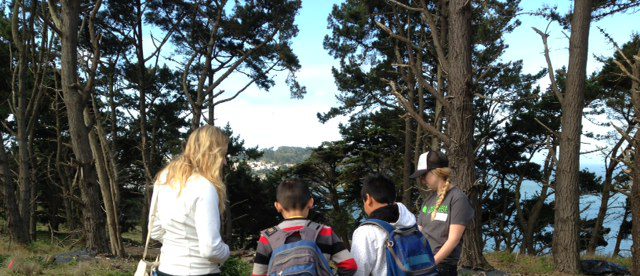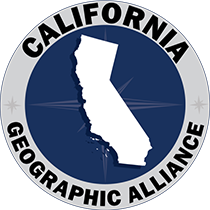At the CGA, our goal is to help build geo-literate citizens who care about the planet’s people, places and environments, and who feel empowered to strive for a more sustainable and equitable world. Teachers, informal educators, parents, students, policy-makers, and the media are all partners in helping us achieve this goal, and the Alliance website is a vehicle for educating, activating, coordinating, and supporting those partners. With this understanding, our team at SDSU, with input from CGA members, has completely revamped the site and is continuing to build out its utility. While the site is changing weekly and should present more value to all audiences as we continue our work, I am going to take this opportunity to give you a quick overview of what you can find there and how you can help us build a better online resource. From the welcome page on, we want the site to support our collective mission.
Teachers (and by extension their students) are our primary audience, and that is reflected in the content we have put online. Under the RESOURCES tab on our main menu, you will find three categories:
CALIFORNIA ATLAS: Our excellent print atlas, California: A Changing State, is available on the site as individual pdf files. You can print pages as needed for student work or project the maps for instruction. The atlas is aligned with fourth grade curriculum and has accompanying lessons for that grade, but it can be a valuable resource at many different grade levels and across a variety of subjects. In addition to the individual maps, the atlas contains great info about how to understand and use maps. If you dig deep into this section (or link directly from the menu on the left margin of the site), you will find “Atlas 2.0” – our working title for a suite of exciting new interactive resources. We have created several web maps and StoryMaps based on the topics covered in the print atlas but incorporating greatly expanded information in a format that allows teachers and students to explore important aspects of California’s history and environment through integrated maps, texts, and images. These are early prototypes, and we will continue to develop them with the help of some talented graduate students at SDSU and the input of teachers. Tell us what you think, suggest additions, or get online with Esri at http://storymaps.arcgis.com/en/ to see many more examples and experiment with making your own StoryMaps. Then share your work.
CONTRIBUTED LESSONS: This is a list of geography lessons, sorted by grade level, that have been created by CGA Teacher Consultants and other teachers who have attended past workshops. We would like to be able to make this list more valuable by adding new model lesson plans and including some info with each lesson plan about what teachers find useful about each lesson plan (kind of user reviews, as we have all become accustomed to online). So send us your best lesson plans, tell us what you think about the ones that are online now, and help us build a better resource.
ONLINE EDUCATIONAL RESOURCES AND MULTIMEDIA CONTENT: One of our concepts for creating a valuable one-stop shopping experience for geo-educators of all types is to be a curator to help people access the best of literally thousands of amazing resources that already exist online. Again, we are very open to reviews and recommendations, but you will find links to sites with lesson plans and online tools, and you will also find links to a lot of short videos that could be used to introduce students to a topic or stimulate critical discussion. For example, The Economist magazine puts out very informative “videographics” on topics such as global migration flows (http://www.youtube.com/watch?v=hcoOENLfpUI), and series of videos created by independent filmmakers such as one entitled Gas Rush explores the boom in natural gas and fracking from a variety of perspectives and features interviews with real people working in or affected by the industry (http://www.gasrushstories.com/grs/Stories.html).
There is also some useful information for educators under the ABOUT tab on the main menu, including:
ABOUT THE CGA: This gives a brief history of the organization. We should all be proud of being the first alliance in the country and one of the places where the movement was first imagined and nurtured.
GEO-LITERACY AND GEOGRAPHY EDUCATION: This page includes texts and links to videos explaining exactly what geography is and why it is vitally important. Geo-literacy is a term that is used within the geography education community to underscore the central importance of geographic knowledge and spatial thinking. We see it as a core competence for the students of today and the citizens of the future. On this page you will also find links to the California content standards and curriculum framework for history and social studies, common core state standards (Did you know there are free iPhone/iPad and Android apps with the Common Core standards?), and the Next Generation Science Standards. Those are the crucial policies for teachers, but the CGA is also looking beyond what is in place to think of what geography education could and should look like, and you can get some ideas about that from following links to A Road Map for 21st Century Geography Education or Geography for Life.
GEOGRAPHY MAJORS AND CAREERS: When the SDSU leadership team decided to take on hosting the CGA, we set a goal to increase the number of incoming college students who declare geography as a major. Unfortunately, this is a rare occurrence, and we think it would be good for our economy, our communities, and our students’ futures if more chose to study geography and prepare themselves for careers as geographers or in many other professions where geographic knowledge and skills are valued. Toward that end, we have included information about why a student might choose geography as a major and where in the US a student could pursue an education in geography. We also link to the site of the Association of American Geographers that includes profiles of professional geographers. And while you are on the site, check out one of our latest blog posts that confirms that geographers’ sensibilities and skills are prized in the workplace and jobs for people with the technical ability to work with geographic information are well-paid and more numerous than job-seekers with the required training. This message needs to get out to our high school students. Geography is relevant, interesting, integrative, and a pathway to a great career.
Thanks for reading! I hope you will visit calgeography.sdsu.edu again and again because it is a valuable resource. And please contribute your own content or suggestions to make it the best possible reflection of the important work we are all doing in geography education.
Cheers,
Tom Herman, CGA Director
therman@mail.sdsu.edu




